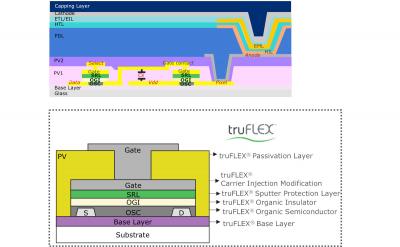AMOLED - introduction and market status - Page 4
Japan Display to start producing eLeap laptop displays at its 6-Gen Mobara fab, ahead of schedule
In 2022, Japan Display (JDI) announced that it has developed a "historic breakthrough in display technology" - a new OLED deposition process which they refer to as eLEAP, that is said to be cost effective and can be used to create freeform OLEDs that are brighter, more efficient, and longer lasting compared to OLEDs produced using mask evaporation (FMM).
JDI is planning to establish a 8.7-Gen eLEAP fab in China, and it is also building a smaller-scale 6-Gen eLEAP production line in Mobara, Japan. The company announced that the 6-Gen Mobara fab is advancing ahead of schedule, and production of eLEAP panels will begin before the end of 2024. JDI developed 14" laptop panels that are three times brighter than other OLEDs (at 1,600 nits), and is also targeting smartwatches, smartphones and automotive displays. JDI is also looking into adopting a tandem structure, to increase brightness even further to 3,000 nits.
Nintendo sold over 7 million Switch OLED consoles in Japan alone, over 20 million units globally
In October 2021, Nintendo launched its first OLED gaming console, the Nintendo Switch OLED. The new OLED device is popular - eight months after the launch Nintendo announced it shipped over 5.8 million devices, and now the company announced it has sold over 7 million Nintendo Switch OLED devices in Japan alone. Nintendo is now selling around 2.5 million units per quarter, and this means that global sales are likely over 20 million.
The Nintendo Switch is a popular device - total lifetime sales across all variants are over 130 million units. The OLED model was the clear preference for people buying a Switch recently. The Nintendo Switch OLED model is an upgrade to the original Switch with a 7-inch 1280x720 OLED display (produced by Samsung Display). The Nintendo Switch OLED model is now shipping globally for $349.
Samsung Display increases focus on small and medium AMOLED production
A report from Korea suggests that SDC has transferred around 500 of its engineers from its large-area OLED development division, or about 30% of them, to its divisions that focus on small and medium-sized AMOLED development.

Samsung tri-folding AMOLED prototype
According to the report, the main reason for SDC's change of priorities is due to the need to remain competitive with Chinese-based OLED makers that are offering OLED panels at low costs. Samsung estimates that it is ahead of its Chinese competitors by only a year or a year and half, and it is just a matter of time until Chinese companies catch up with South Korea makers (SDC and LGD).
BOE starts constructing its 8.6-Gen IT flexible AMOLED line in Chengdu
Towards the end of 2023, BOE officially announced its plans for a 8.6-Gen flexible LTPO AMOLED line in Chengdu. The agreement with Chengdu's local government was signed in early 2024, and now BOE started to construct its new production line.
The total investment in the fab is expected to reach 63 billion Yuan (over $8.7 billion USD). The fab will have a capacity of 32,000 monthly substrates (2290x2620 mm), and is expected to begin production by Q4 2026 (total construction time will be 34 months, according to the plan).
Reports suggest BOE and perhaps Tianma to supply all the AMOLEDs for Apple's iPhone SE 4
A report from China suggests that Samsung will not produce any AMOLEDs for the upcoming Apple iPhone SE 4, as the Korean maker asked for around $30 per unit (6.1-inch) which was too high for Apple. Apple apparently wanted to pay only $25, and it is estimated that BOE will supply most of the units, with some orders perhaps going to Tianma.
According to reports, Samsung estimated that it will not be able to make a profit in this project and decided to stop the negotiations when Apple insisted on a low price.
RitDisplay to produce OTFT-driven AMOLED displays by 2026 in collaboration with Smartkem
UK-based OTFT display backplane developer SmartKem announced that it signed a collaboration agreement with based PMOLED-maker RiTdisplay, for the production of OTFT-based AMOLED displays. SmartKem further said that Innovate UK and the Taiwanese Ministry of Economic Affairs will support this project with a grant of around $530,000.
Smartkem will provide its proprietary OTFT materials to RiTdisplay to integrate within its OLED displays. If successful, the project will create the world's first commercially ready AMOLED display made using organic transistors, which will outperform RiT's PMOLEDs with higher brightness, lower power consumption and higher resolutions. Both companies hope that the project will be completed in 2026.
Samsung announce a new Flex Magic Pixel technology for enhanced OLED privacy
Samsung Display demonstrated a new technology it brands as Flex Magic Pixel, that adjusts the viewing angle of the flexible OLED screen so that it is not visible to the person next to it. Samsung says that when this technology is combined with the proper AI technology, can be used to enhance the security of smart devices.
Samsung gives a use case example - when a smart device user runs a banking application in a public place, AI technology can automatically recognize the environment and initiate additional security features. The company's new Flex Magic Pixel enables the introduction of dynamic OLED privacy. Samsung Display is showing the new application at MWC 2024.
New OLED TVs, monitors, laptops and prototypes announced at CES 2024
During CES 2024, many device makers announced new laptops, monitors and TVs that use OLED displays. Here's a list of all these new devices:
- MSI Monarch 13 laptop (13.3" 2.8K AMOLED)
- LG OLED B4, C4, G4, M4 (WOLED TVs)
- Samsung Odyssey G9 monitor (49" 5120x1440 240Hz QD-OLED)
- Samsung Odyssey G8 / G6 monitors (27" 1440p 360Hz / 32" 4K 240Hz QD-OLED)
- Razer Blade 16 2024 laptop (16" 2560x1600 240Hz SDC AMOLED)
- Dell 2024 XPS 13 / 14 / 16 laptops (16" 90Hz 4K / 14.5" 120Hz 3200x2000 / 13.4" 2880x1800 60Hz AMOLED)
- Acer Predator X34 X / X39 monitors (4" / 39" 3440x1440 240Hz OLED)
- LG Signature OLED T (77" 4K wireless transparent WOLED TV)
- Samsung S95D, S90D, S85D (QD-OLED and WOLED TVs)
- Gigabyte AORUS 2024 QD-OLED monitors (27", 31.5", 34" QD-OLEDs)
- Acer 2024 Swift 14 X / Swift Go 14 / Swift Go 16 laptops (14" / 16" AMOLEDs)
- Panasonic Z93A, Z95A (WOLED TVs)
- HP Omen Transcend 32 gaming monitor (32" 240Hz 4K QD-OLED)
- Dell Alienware AW2725DF / AW3225QF monitors (27", 32" QD-OLEDs)
- HP 2024 Spectre x360 14 laptop (14" AMOLED)
BOE shows a dual-slidable laptop AMOLED display
BOE signs the official contract with Chengdu's local government to build its 8.5-Gen IT AMOLED line
BOE has been planning a 8.5-Gen flexible IT AMOLED Line for a couple of years, and in November 2023, following some delays, the company officially announced its plans for the new fab. Now we hear from China that the Chengdu local government, together with Chengdu's Hi-Tech Industrial Development Zone, have signed the contact with BOE to build the new plant.
The total investment in the fab is expected to reach 63 billion Yuan (over $8.7 billion USD). The fab will have a capacity of 32,000 monthly substrates (2290x2620 mm), and is expected to begin production by Q4 2026 (total construction time will be 34 months, according to the plan).
Pagination
- Previous page
- Page 4
- Next page







